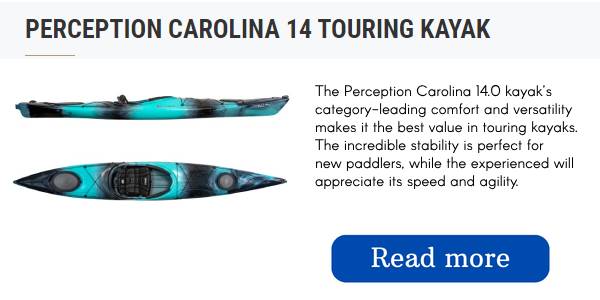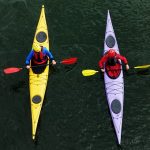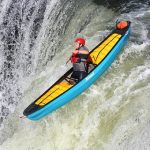While you may be able to tell the difference between a kayak and canoe by looking at them, many people cannot. They are often confused, even though there are quite a few differences between the two. This article will provide a brief history of both kayaking and canoeing, as well as look at some of their similarities and differences. It will also identify what type of people each boat is best suited for.
Differences And Benefits You Need to Know
– Canoes are larger and can hold more people and gear than kayaks. – Kayaks are designed so that you sit inside of them, while canoes have an open design. – Canoes are paddled with a single-bladed paddle, while kayaks are paddled with a double-bladed paddle.
Canoes are larger boats that can hold more people and gear than kayaks. You sit inside of kayaks, while canoe design is more open. Canoes are paddled with a single-bladed paddle, while kayaks use a double-bladed paddle.
Cockpit
A canoe is a type of boat that does not have a cockpit and is open like a rowing boat.
While canoes are open with room for multiple people, kayaks are closed off with a space for only one person. They also sit lower in the water, so people often wear spray skirts to keep water out.
Seat
Most canoes have bench-like seats that raise the paddler from the boat floor. Canoeists usually sit in pairs, but some canoes have room for three people. In challenging conditions or when trying to generate more power, some canoeists prefer to kneel on the floor.
Kayakers sit in a seat that is usually molded to the bottom of the kayak, with their legs out in front of them. Kayakers use their knees to brace against the sides of the kayak and advanced paddlers will use this to their advantage when paddling. Their legs act as a rudder, giving them more control over the direction in which they are going.
Paddles
Canoes are paddle with a single paddle that can be used on either side. Paddlers can use a ‘J’ stroke to paddle in a straight line without having to swap sides.
Kayakers use a double paddle that has a paddle ‘blade’ on both ends. They will paddle on opposite sides to move the kayak forward.
Debunking Myths
If you’re undecided about which model of car to buy, you will inevitably encounter some myths about the topic. However, most of these myths aren’t true and are simply created by sellers to steer you towards one model or the other. Let’s take a look at a few of the most common myths and examine how accurate they are.
Paddling a Canoe Requires More Skill
This is false. Although a beginner in a kayak may appear to be doing better than a beginner in a canoe, this is only the case in calm water. In rougher conditions, a solo kayak is more difficult to maneuver. Thus, it takes longer to master both the kayak and the canoe.
The only difference is that the canoe has a steeper learning curve, but once you get the hang of it, it is just as easy as the kayak.
A Kayak Is Faster Than a Canoe
Two common types of boats are hulls and their speed is determined by how long they are. If a boat is thinner, it will be faster. However, if a boat is fat or skinny, it will not affect the speed if the boat is the same length.
The reason why some people would prefer a kayak over a canoe is because it is easier to paddle even though the speed might be the same.
A Single Paddle Is Much Harder to Use
While a double-blade paddle is more efficient, it is also much heavier. This can cause issues with wind resistance and may lead to tendonitis. Some people opt for non-directional blades to avoid these issues.
A Canoe Is Far Less Comfortable Than a Kayak
The diagram below shows the difference in construction between a kayak and a canoe. The location of the seat in a canoe as opposed to a kayak is a result of the different construction of the two types of watercraft.
As mentioned earlier, a kayak has a closed hull design, whereas a canoe has an open hull. This means that when you are inside a kayak, you are effectively wearing it, and situations such as portages, downed trees, or docks can pose problems when you want to get in or out of the kayak.
This is especially true if you are not particularly athletic. Additionally, the cramped quarters inside the kayak, and the fact that your legs are out in front of you, can make for an uncomfortable and even dangerous experience.
Water can also enter the kayak through the paddle drip rings, making for a wet and uncomfortable ride. While you can mitigate some of these problems by wearing a spray skirt or dry suit top, this is not ideal in warm weather.
If you’re interested in canoeing for the purpose of fishing or photography, you’ll get a much more stable platform with a better view of your surroundings from a higher position.
Canoe vs Kayak: Which Is Better?
Now that you know the difference between canoeing and kayaking, you may be wondering which is better. This is not a question to ask an avid kayaker, as they will likely only point out the disadvantages of canoeing.
Likewise, a canoe fan will champion canoeing. But at some point, they must have asked the same question about canoeing and kayaking, and they can’t both be right.
The question of whether a canoe or kayak is better can be looked at by the pros and cons of each.
Pros for Canoeing
- You can carry lots of gear easily in a canoe
- They are ideal for more extended expeditions due to their comfort and carrying capacity
- Canoes are more stable than kayaks and more difficult to capsize
- You can vary your sitting position making it more comfortable than kayaking – especially over long distances
- You can stand up
- Once you’ve learned the basics, mastering canoeing skills is quicker and easier than kayaking
- Unless paddling on whitewater, you won’t get very wet in a canoe
- You get a better view of your surroundings than in a kayak
- Portaging (by-passing sections of the river on land) regularly on a trip is much easier than in a kayak – especially if you are carrying lots of gear
- You can easily bring young kids and dogs out on the water
- Canoes are easy to get in and out of
Cons for Canoeing
- Heavy, big, and can be difficult to transport and store
- It is initially difficult to master basic paddling skills – especially as a solo paddler
- Canoes take on more water than kayaks when paddling on whitewater
- Single paddles are less efficient than double paddles
- It takes more effort to paddle a canoe at top speed than to paddle a kayak at top speed
Pros for Kayaking
- It is easy and quick to pick up the basics of kayaking
- Kayaks go faster, with less effort exerted by the paddler than canoes do
- There is much more variety in kayaking disciplines than there is in canoeing
- Your gear will be kept drier in a kayak than in a canoe (providing you don’t capsize!)
- They are lighter and easier to transport than canoes
- Kayaks are more maneuverable than canoes
- Kayaks handle whitewater better than canoes
- You are close to the water in a kayak which can make you feel much more connected with the water than in a canoe
- Double kayak paddles are more efficient than single canoe paddles
Cons for Kayaking
- It is unlikely you’ll come away from a kayaking session dry
- It can take a long time to master more advanced kayaking skills
- It can be scary transitioning from kayaking on flat water to fast-moving water
- Using a spray skirt can be a little scary for learners and improvers
- Double paddles are heavier than single paddles
The Verdict
Canoeing and kayaking both have a lot of advantages, and the one you choose to do depends on your circumstances and what you prefer. Then if you’re still not sure, here are a few more things to consider:
- Where will you be paddling the most?
- Who will you be paddling with?
- What sort of paddling trips would you like to be going on?
- Will you be traveling for days at a time deep into the wilderness? Or would you rather a quick hour here and there flexing your paddling muscles?
- What car do you have? Is it a tiny Mini with no roof rack? Or have you got a huge truck?
If you’re wondering what I think is better, a canoe or kayak, I can give you a definitive answer. I’ve spent a fair amount of time teaching and enjoying both canoeing and kayaking, so I know a lot about them. Unfortunately, it depends on you as a person and what you want to get out of your time on the water.
Canoes and kayaks are two different types of boats that are used for different purposes. Canoes are open, while sit-in kayaks are closed. Canoes are better suited for flat, calm waters, while a kayak is ideal for many things and can be specialized for white water rapids.
A canoe requires a single-blade paddle, which requires switching to both sides in an alternating matter, while with a kayak you get a double-blade paddle. However, the kayak’s paddle is heavier and requires a more careful technique.
With a kayak, you can learn the basics in a pretty short time, while with a canoe it will take a while before you can maneuver it with ease. However, once you do get the hang of both, a kayak is much more challenging as far as advanced techniques go.
It all comes down to what you need and what you will use it for. The fundamental difference between the two, the purpose, could very well be the deciding factor.
If you live, or travel often, to an area that has calm, flat waters, a canoe will be much better, even though it will take you a little longer to get the hang of it.
On the other hand, if you live, or often travel, to the mountains or the open ocean, and you have fast-flowing water and rapids, a canoe can be a disaster, and you need a kayak.
So, if you don’t want to make a mistake, give your needs and requirements a good thought, and make your decision.




